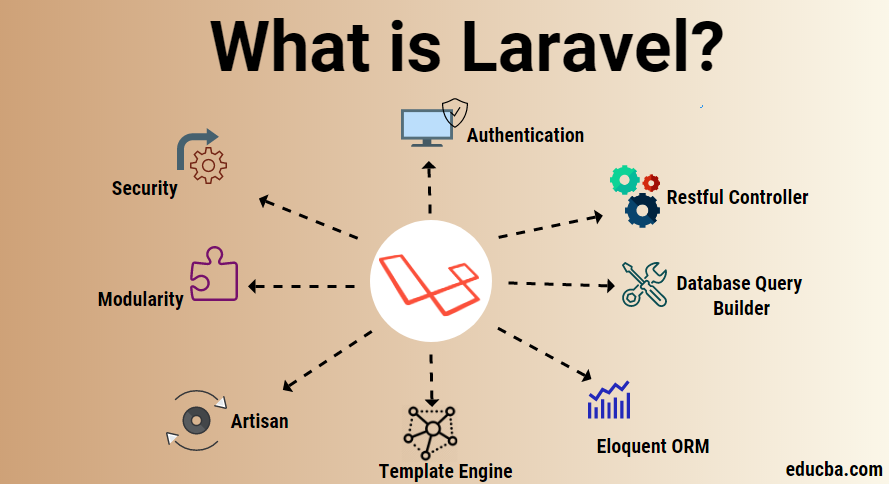
Introduction to Laravel
It is a simple PHP framework frequently used for web-based or web application development that is known for its exceptional characteristics like reliability, high performance, finer efficiency, articulated ORM systems, a multiplicity of Authentication options, expandability, modularity, facilitates caching, secure SQL processing, dedicated SQL builder, restful controller, uncomplicated coding rules, etc. This PHP framework permits the code developers for specific templating, routing flow provision, and database manipulation/ querying.
Key Features of Laravel
Its framework has a vast ecosystem with immediate deployment, routing, templating, ORM, DB query, and listing.
1. Dependency Management
Dependence leadership is one of the greatest characteristics; the key aspect of learning contemporary internet apps is understanding the functionality of service container (IoC). The strong instrument for managing class dependencies in Laravel development is the IoC (Control Invert) or service container. Dependency Injection is a means of removing and injecting hard-coded courses via a composer-like instrument.
2. Modularity
Modularity is the degree of separation and recombination of the parts of a web application. You can divide the company logic into components that function as a web application. It is intended for modular use and is also a set of parts. Using a modular framework, you can easily create and design a wide-ranging company application. It offers a very easy guide for creating the Laravel of modules or packages.
3. Authentication
Authentication is a component of every contemporary web application. However, it can take a lot of your development time to write authentication to another framework, such as Codeigniter. Therefore, it offers a box authentication that allows you to build a fully functional authentication scheme using an easy command. It also provides convenient paperwork for your authentication.
4. Caching
Caching is temporarily storing information in a convenient location, allowing for quick retrieval when needed. Caching is mostly used to improve the application’s efficiency. For example, nearly all data from perspective to paths is cached in Laravel. This reduces the processing time by helping it to increase efficiency.
5. Routing
It is simple to comprehend routing in Laravel and similar to the rail frame of Ruby. Routing of it can be used for easily creating a restful application. You can group, name, filter, and connect your model information to the paths. Its routes can be very flexible and controlled to create search engine-friendly URLs.
6. Security
Laravel offers an intuitive way to generate safe web apps. Instead of plain text passwords, It saves all passwords as a hash. To hash passwords, It uses BCrytp. In addition, it offers SQL injection attack safety and escapes all user entries to inject script tags.
7. Migration System
Like Ruby on Rails, It provides a migration system to build databases. However, you can use PHP instead of SQL to write the migrants that produce your database structure. You can use these migrations to create bases, tables, and indexes. Instead, you can execute a new migration; if you want to change the table column, you do not need to repeat creating the table again.
8. Artisan
Artisan is the name of Laravel’s command-line tool. It includes dozens of pre-built commands which can be used to perform tasks with a command-line interface. During the development process, this tool can avoid the most repetitive tasks.
9. Database Query Builder
The builder of Laravel’s query database offers an easy way to create database requests. It includes many helper functions that you can use to filter your data down. Laravel links provide an easy way to implement complex queries. Laravel query builder syntax makes writing database queries easy to understand and enjoy.
10. Template Engine
The blade is Laravel’s templating motor. Blade offers a few helper functions to format your data in the view. The blade also uses the heritage template for creating complex layouts. The file extension of all blade templates.
11. Eloquent ORM
The eloquent ORM in Laravel is based on a database abstraction layer, which supports nearly all popular database engines. MySQL and SQLite work perfectly. It supplies all eloquent functions with comprehensive documentation.
12. Restful Controllers
The restful controllers of Laravel allow you to separate the logic behind the requests of GET or POST. It is also possible to produce resource controllers that are easy to use to generate CRUD. You can then connect the resource controller to the path to service all CRUD paths automatically.
Advantages
Given below are the advantages mentioned:
- It embraces a general philosophy of growth that gives high priority to code creation.
- You should maintain a fast growth rate by following a few straightforward rules and altering your code with little fear of violating current features.
Conclusion
In this article, we have seen basic meaning, features, and advantages because of all the above characteristics and continual enhancement. It has been demonstrated to be the finest PHP framework. This is why it is the most used PHP framework. It helps to build a strong application using easy, expressive methods.
Recommended Articles
We hope that this EDUCBA information on “What is Laravel?” was beneficial to you. You can view EDUCBA’s recommended articles for more information.

